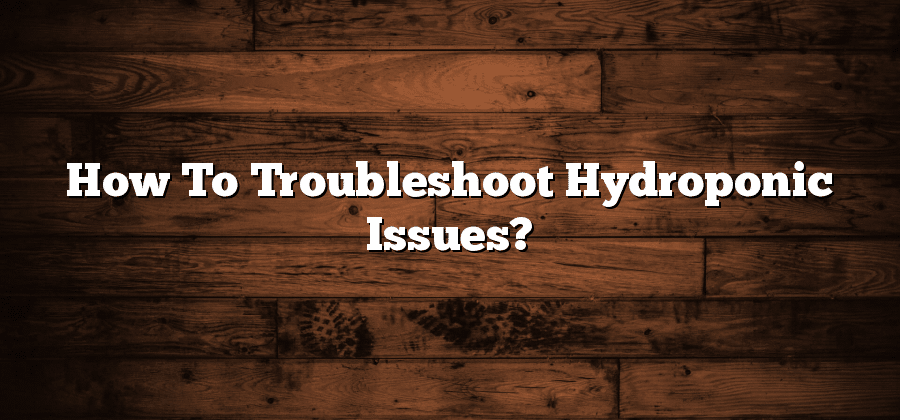Identifying Common Hydroponic Problems
One of the key challenges in hydroponic gardening is identifying and troubleshooting common problems that can arise. These issues can range from nutrient deficiencies to pH imbalances, temperature fluctuations, and light intensity issues. By being able to recognize these problems early on, hydroponic gardeners can take proactive steps to address them and ensure optimal plant growth and development.
One common problem that hydroponic growers may encounter is nutrient deficiencies. Since plants in a hydroponic system rely solely on nutrient solutions for their growth, it is crucial to provide them with the right balance of essential nutrients. Signs of nutrient deficiencies can manifest in various ways, such as yellowing or wilting leaves, stunted growth, or poor fruit development. By carefully monitoring plant health and regularly analyzing the nutrient solution, growers can pinpoint specific deficiencies and take corrective measures, such as adjusting nutrient concentrations or supplementing with specific micronutrients.
Preventing Nutrient Deficiencies
One of the key challenges of hydroponic gardening is preventing nutrient deficiencies. Unlike traditional soil-based gardening, hydroponic systems rely on nutrient solutions to provide plants with the essential elements they need to grow and thrive. Without the proper balance of nutrients, plants may suffer from stunted growth, leaf discoloration, or even complete crop failure.
To prevent nutrient deficiencies, it is vital to regularly monitor the nutrient levels in your hydroponic system. This can be done through regular testing of the nutrient solution using a pH and conductivity meter. By keeping a close eye on the nutrient levels, you can ensure that your plants are receiving the appropriate amount of each essential element. Additionally, it is essential to follow a precise feeding schedule and adjust the nutrient solution accordingly based on the growth stage of your plants. Remember, prevention is always better than cure when it comes to nutrient deficiencies in hydroponic systems.
Detecting pH Imbalances
One of the key factors in maintaining a successful hydroponic system is monitoring and maintaining the pH level. pH refers to the acidity or alkalinity of the nutrient solution. A pH imbalance can lead to nutrient lockout, causing plants to suffer from nutrient deficiencies and stunted growth. Therefore, it is important to detect any pH imbalances and address them promptly to ensure optimal plant health and growth.
There are several signs that indicate a pH imbalance in a hydroponic system. One common indicator is the appearance of plant leaves. If the leaves start to yellow, brown, or show signs of discoloration, it may be a sign that the pH level is too high or too low. Additionally, if you notice slow or stunted growth, it could also be a result of pH imbalance. It is crucial to regularly inspect and monitor the plants for any signs of distress, as early detection of pH imbalances can prevent further damage and allow for timely corrective measures.
Addressing Temperature Fluctuations
Temperature fluctuations can be a common problem faced by hydroponic gardeners. Fluctuations in temperature can negatively impact the growth and development of plants, leading to poor yields and even crop failure. It is therefore crucial to address and manage temperature fluctuations effectively to ensure optimal plant growth and health.
One effective way to address temperature fluctuations is by using insulation materials. Insulating the growing area can help regulate temperatures by reducing heat loss during cooler periods and preventing excessive heat buildup during warmer periods. Reflective materials, such as foil blankets or reflective sheeting, can also be used to bounce back excess heat and light, providing a more stable and balanced environment for the plants. Additionally, using temperature control devices, such as fans, heaters, or coolers, can help maintain a consistent temperature range. Regular monitoring of the temperature and adjusting the control devices accordingly is essential to ensure a stable and optimal climate for hydroponic plants.
Resolving Light Intensity Issues
In a hydroponic system, maintaining the proper light intensity is crucial for the healthy growth of plants. Insufficient light can lead to weak and elongated stems, while excessive light can cause leaf burn and stunted growth. Thankfully, there are several strategies you can implement to resolve light intensity issues and ensure optimal conditions for your plants.
Firstly, consider upgrading your lighting system. Investing in high-quality LED grow lights can not only provide the necessary intensity but also offer energy efficiency and a longer lifespan. Additionally, adjustable light fixtures allow you to customize the light intensity based on the specific needs of your plants at different growth stages. Furthermore, placing reflective materials, such as aluminum foil or reflective sheets, around the growing area helps in maximizing the available light by reducing light loss and directing it towards the plants. Remember to position the lights at an appropriate distance above the plants, as different species have varying light requirements. Regularly monitor the light intensity and make adjustments accordingly to provide an optimal growing environment for your hydroponic crops.






